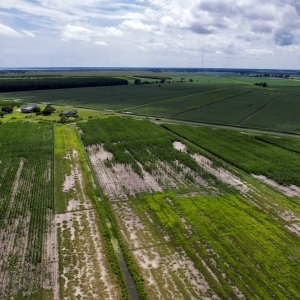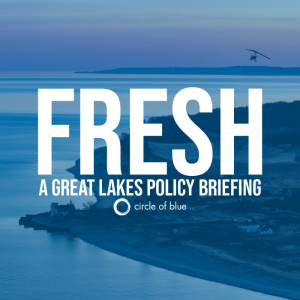This week’s episode of What’s Up With Water covers a potential catastrophic winter storm in California and new research that revealed what may be causing high case numbers of pediatric cancer in Pennsylvania. Plus, Circle of Blue breaks down the latest water cuts in the Colorado River basin.
Transcript
Welcome to “What’s Up With Water” – your need-to-know news of the world’s water from Circle of Blue. I’m Eileen Wray-McCann.
Even as drought makes the headlines in the western United States, new research warns that public officials should also be planning for a an opposite risk: catastrophic floods. A massive winter rain and snow storm could hit California this century, with widespread damage to the country’s most populated state. That’s according to a new study from researchers at the University of California, Los Angeles. The Pacific coast is no stranger to heavy rainfall, but climate change is strengthening the plumes of tropical moisture that can hit California like a firehose. At the same time, the nature of precipitation is changing – it’s falling more as rain than snow, which means rivers rise faster than usual in the winter. Together, the two trends are a major threat. The study warns that a superstorm could dump nearly 16 inches of precipitation across California within a month. According to the New York Times, a storm like that would test the limits of dams, levees and other water infrastructure that is meant to shield cities from storms.
In health news, a study from the Yale School of Public Health says that children living close to oil and gas fracking sites in Pennsylvania have a heightened risk of the leading form of pediatric cancer. Researchers based their work on 405 children who were diagnosed with acute lymphoblastic leukemia between 2009 and 2017. They found that children born within about a mile of a fracking site were two to three times more likely to be diagnosed with leukemia. This suggests that exposure during the mother’s pregnancy is a risk factor. The study also notes that drinking water could play a significant part in exposure to oil & gas-related chemicals. Unconventional oil and gas development, also known as hydraulic fracturing or “fracking,” uses many chemicals that are known or suspected to cause cancer. Most states have public health measures that prevent exposure to these substances, such as a “setback distance” between a home and the nearest fracking site. Pennsylvania has a minimum setback distance of 500 feet. The study’s authors say that existing setback distances, which in some states are as low as 150 feet, are putting children at risk.
This week Circle of Blue reports on the restrictive water cuts coming next year to the Colorado River basin.
The Colorado River is in a precarious state – and the consequences are sharpening with a federal study determining how the basin’s major reservoirs will be operated next year — and which states will have to limit their water withdrawals from the shrinking river.
With key water supply reservoirs Mead and Powell near record lows, Arizona, Nevada, and Mexico will bear the largest cuts in their use of the Colorado River to date.
The largest burden falls on Arizona, which will see its allocation reduced by 21 percent. Under the voluntary agreement signed in 2019 that governs the cuts, no other basin state is required to limit its withdrawals. Federal officials have requested additional reductions in order to protect Mead and Powell. However, the seven basin states did not meet a federal deadline to present a plan to achieve the conservation goals. The aim: to save two to four million acre-feet of water next year. At the high end, that amount of conservation is nearly five times as much as the cuts announced on August 16 and roughly equal to a third of the Colorado River’s recent annual flow. Camille Touton, commissioner of the Bureau of Reclamation, told the states in June that unless they acted, the federal government would “protect the system” and apply its own remedy. The states missed that 60-day deadline and remain in fractious negotiations.
Without the additional cuts, Mead is projected to drop another 20 feet within a year due to reduced releases from Powell, which is located upstream. Mead is a V-shaped reservoir, so it declines more rapidly at its lower levels. And because Lake Powell is so low, only 7 million acre-feet will be released next year, which is not enough supply to meet typical demand.
Even as the basin states and Mexico continue to negotiate additional cuts, they will be taking the reductions dictated by the Bureau of Reclamation’s study. The projections in the study are based on what’s called a “most probable” scenario – on flows into the reservoirs that would be greater half the time. Runoff in the basin, however, has trended in the opposite direction, with consistently below average flow numbers for the last three years because of dry soils and high temperatures. To account for this, Reclamation also runs what’s called a “probable minimum” scenario. It’s not worst case, but it’s close. In that scenario, there are severe outcomes. By the end of next year, Lake Powell would be too low to generate hydropower. By the summer of 2024, Lake Mead would be just 100 feet above dead pool, a level at which no water flows downstream.
These potential and daunting futures are why Commissioner Touton ordered the states to impose extra conservation and why the U.S. Congress included $4 billion in drought response funds in the Inflation Reduction Act, signed last week by President Biden. The negotiations between the states, however, have stalled amid accusations that proposals lack urgency and are short-sighted.
John Entsminger is general manager of the Southern Nevada Water Authority, which supplies Las Vegas. In an August 15 letter to federal officials, he laid out his concerns. Entsminger accused special interests of “drought profiteering” by seeking inflated payments for reducing their water use. He described a lack of “meaningful collective action to help forestall the looming crisis.” He added: “Writing the next chapter will require each and every water manager to convince their elected officials and governing bodies that sacrificing something is the only way to save everything.”
And that’s “What’s Up With Water” from Circle of Blue, where water speaks. More water news and analysis await you at circleofblue.org. This is Eileen Wray-McCann – thanks for being here.
Jane is a Communications Associate for Circle of Blue. She writes The Stream and has covered domestic and international water issues for Circle of Blue. She is a recent graduate of Grand Valley State University, where she studied Multimedia Journalism and Women, Gender and Sexuality Studies. During her time at Grand Valley, she was the host of the Community Service Learning Center podcast Be the Change. Currently based in Grand Rapids, Michigan, Jane enjoys listening to music, reading and spending time outdoors.






